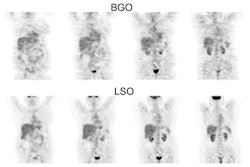J Nucl Med 2001 Jan;42(1):9-16
Glucose metabolism of breast cancer assessed by 18F-FDG PET: histologic and
immunohistochemical tissue analysis.
Avril N, Menzel M, Dose J, Schelling M, Weber W, Janicke F, Nathrath W,
Schwaiger M.
Breast cancer is characterized by elevated glucose consumption resulting in
increased uptake of 18F-FDG. However, tracer uptake varies considerably among
tumors imaged with PET. This study compared histologic and immunohistochemical
tissue analysis of breast carcinomas with preoperative FDG uptake assessed by
PET to identify tumor characteristics that define the degree of tracer
accumulation. METHODS: FDG uptake in breast tumors was quantified by calculating
standardized uptake values (SUVs) corrected for partial-volume effect and
normalized to blood glucose level at the time of tracer injection. The
histologic sections of 50 invasive and 6 noninvasive breast carcinomas were
analyzed for histologic type, microscopic tumor growth pattern, percentage of
tumor cells, presence of inflammatory cells, density of blood vessels,
histopathologic grading, tumor cell proliferation (mitotic rate and antibody
binding of MIB-1), expression of estrogen and progesterone receptors, and
expression of the glucose transporter protein Glut-1. RESULTS: A positive
correlation was found between FDG uptake and histologic tumor type (ductal vs.
lobular; P = 0.003), microscopic tumor growth pattern (nodular vs. diffuse; P =
0.007), and tumor cell proliferation (MIB-1; P = 0.009). Tumors with diffuse
growth patterns had significantly lower SUVs compared with clearly defined
tumors. A weak relationship was found between FDG uptake and the percentage of
tumor cells (P = 0.06). Lower densities of blood vessels corresponded to higher
FDG uptakes (P = 0.08). However, even significant correlations showed poor
correlation coefficients. No relationship was found between FDG uptake and the
following: tumor size; axillary lymph node status; percentage of necrotic,
fibrotic, and cystic compounds; presence of inflammatory cells; steroid receptor
status; and expression of Glut-1. CONCLUSION: Histologic and immunohistochemical
tissue analysis was unable to sufficiently explain the variation of FDG uptake
in breast cancer. The degree of metabolic changes after malignant transformation
is most likely explained by a complex interaction between cellular energy demand
and tumoral microenvironment. Therefore, FDG PET imaging may not be used to
estimate tumor biologic behavior of breast cancer such as differentiation,
histopathologic grading, cell proliferation, or axillary lymph node status.





